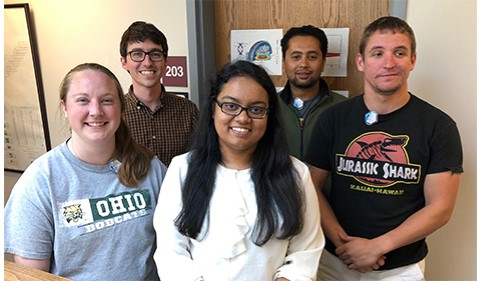
Ohio University physicists Kristyn Brandenburg, Zach Meisel, Chowdhury Irin Sultana (M.S. 2019, now a doctoral student at Central Michigan University), Shiv Subedi, and Doug Soltesz
Imagine looking into a mirror at yourself and not recognizing the person staring back at you. The symmetry you are accustomed to is somehow not there. That’s how one member of a team of scientists described a recently discovered phenomenon taking place within the nucleus of an atom.
As team members, Ohio University Assistant Professor Zach Meisel and nuclear physics doctoral students Kristyn Brandenburg, Doug Soltesz, Shiv Subedi, along with their colleagues reported their findings in a paper, ‘Mirror-symmetry violation in bound nuclear ground states’ in the journal Nature, one of the world’s premier scientific journals.
The study was led by Daniel Hoff and Andrew Rogers, nuclear physicists at the University of Massachusetts Lowell (UMass Lowell); the group included researchers from UMass Lowell, OHIO, and Michigan State University (MSU). The announcement received a nod from the Boston Globe.
A UMass Lowell press release explained how the discovery was made. The team was working to determine how atomic nuclei are created in X-ray bursts – explosions that happen on the surface of neutron stars, which are the remnants of massive stars at the end of their life.
The breakthrough by the researchers revealed that a symmetry that exists within the core of atoms is not as fundamental as scientists have believed. The discovery sheds light on the forces at work within the nucleus of atoms, opening the door to a greater understanding of the universe.
“This work found an interesting deviation from the usual pattern of “mirror symmetry” that exists in nuclei,” Meisel said. “Usually, when we switch the number of protons and neutrons in an atomic nucleus, many properties are unchanged. We found the first case where quantum properties known as the spin and parity are different for mirror nuclei that have energetically bound lowest-energy states. This result will change the discussion of mirror symmetry in textbooks and will provide extra constraints for nuclear theory moving forward.”
Meisel and his students traveled to the MSU National Superconducting Cyclotron Laboratory in East Lansing, Michigan, for a week in 2017, to assist in conducting the experiment and data collection. Meisel performed detector simulations used in the data analysis and astrophysics model calculations that are being used for an associated follow-up work.
He pointed to other benefits of the collaboration, such as the beginning of a fruitful collaboration with Rogers’s research group at UMass Lowell.
“We have since worked together on a handful of experiments studying short-lived nuclei at the National Superconducting Cyclotron Laboratory. The U Mass Lowell group has played an important role in the data analysis of a similar experiment that OHIO postdoctoral researcher Mansi Saxena led in February 2020.”
Read the press release and description of the experiment.
Read the abstract and scientific article in Nature.



















Comments